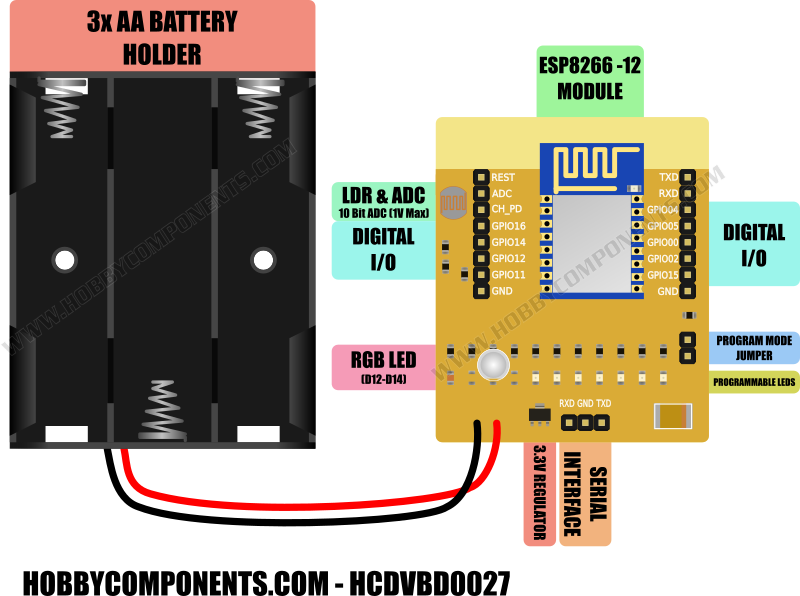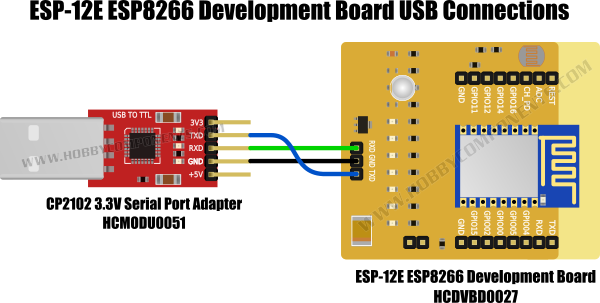

This EPS8266 development board (HCDVBD0027) is based around the very popular and low cost ESP8266 wireless (WiFi) microcontroller module. It uses the ESP-12E version of the module, which is pre-soldered to the development board. The board itself not only provides a set of standard header pins, which gives access to the modules digital and analogue pins, but also includes some extra components that allow the development board to be used as a development platform for experimenting with some of the features of the ESP8266.

Additional features of this development board include:
3x AA battery holder allowing the development board to be used as a portable remote sensor.
A photo-resistive sensor connected to the analogue input of the EPS8266 allowing ambient light levels to be measured.
A 3 colour RGB 5mm LED connected to digital pins 12 (green), 13 (blue), and 15 (red). When used with the PWM capability these pins allow for over a million variations.
6 surface mount LEDs which can be controlled by GPIO pins 0, 2, 4, 5, 14, and 16.
Compatible with the Arduino IDE via the board manager extension.

ESP8266 Module Features:
• 802.11 b/g/n
• Integrated low power 32-bit MCU
• Integrated 10-bit ADC
• Integrated TCP/IP protocol stack
• Integrated TR switch, balun, LNA, power amplifier and matching network
• Integrated PLL, regulators, and power management units
• Supports antenna diversity
• WiFi 2.4 GHz, support WPA/WPA2
• Supports STA/AP/STA+AP operation modes
• Supports Smart Link Function for both Android and iOS devices
• SDIO 2.0, (H) SPI, UART, I2C, I2S, IR Remote Control, PWM, GPIO
• STBC, 1x1 MIMO, 2x1 MIMO
• A-MPDU & A-MSDU aggregation & 0.4s guard interval
• Deep sleep power <10uA, Power down leakage current < 5uA
• Wake up and transmit packets in < 2ms
• Standby power consumption of < 1.0mW (DTIM3)
• +20 dBm output power in 802.11b mode
• Operating temperature range -40C ~ 125C
• FCC, CE, TELEC, WiFi Alliance, and SRRC certified
Notes:
To program the ESP8266 the supplied jumper should be fitted to the programming header. In normal operation this jumper must be removed.
To put the ESP8266 into programming mode cycle either the power supply or the reset pin whilst the programming jumper is inserted.
When in programming mode the RGB LED will be a blue-green colour.
When inserted, the programming jumper will connect GPIO pin 0 to ground. You should therefore avoid configuring GPIO pin 0 as an output.
GPIO maximum current = 12mA
GPIO maximum input voltage = 3.6V
The ADC is capable of measuring analogue input voltages between 0V and 1.1V
Getting Started With Your ESP8266E Development Board
Connecting the ESP8266E to your computer:
To connect the ESP8266E development board to your computer you will need a USB to serial interface adapter. The adapter we recommend is the CP2102 (HCMODU0051) which is specifically designed to interface to devices with 3.3V logic levels.

Programming the ESP8266 development board:
The ESP8266 module is pre-flashed with the AI-Thinker firmware. This will allow the board to be controlled as a slave device via its serial interface. For information on how to use the AI-Thinker firmware please see our blog post here:
http://blog.hobbycomponents.com/?p=165
However, to take advantage of the full features of this development board we recommend using the Arduino Integrated Development Environment (IDE) which can be freely downloaded from the Arduino website (Arduino.cc). A guide on how to setup and use the Arduino IDE with this board can be found on our blog site here:
http://blog.hobbycomponents.com/?p=594
Please note that when used with the Arduino IDE the AT-Thinker firmware will be overwritten.
Example Arduino Blink Sketch:
Code: Select all
/* HCDVBD0027 Blink example - HobbyComponents.com */
#include <ESP8266WiFi.h>
#define PIN 2 // Flash the LED connected to GPIO2
void setup()
{
pinMode(PIN, OUTPUT); // Set the pin to an output
}
void loop()
{
digitalWrite(PIN, LOW); // Turn the LED on
delay(1000); // Wait for a second
digitalWrite(PIN, HIGH); // Turn the LED off
delay(1000); // Wait for another second
}FAQ:
How long will the batteries last?
This depends of several factors such as the capacity of your batteries, the mode of operation, use of LEDs, and WiFi connection.
In its default state the board will consume approximately 70-80mA with peaks of about 200-300mA for very short periods when transmitting. With a standard set of AA alkaline batteries this will give an approximate operating time of about 15 to 17 hours. However, if your application does not require the board to be constantly transmitting or receiving data (for example you only need to transmit sensor data once a minute or so) you can greatly increase this time by taking advantage of the ESP8266's low power sleep and deep sleep modes:
Modem sleep mode -
Using the functions WiFi.forceSleepBegin() & WiFi.forceWake() commands will allow you to power down the ESP8266's radio modem. Whilst the modem is in the off state you will not be able to send or receive data over a WiFi connection, however current consumption of the development board will drop to about 18mA and in turn increasing the operating time of batteries to about 66.6 hours (2.7 days)
Deep sleep -
If the microcontroller within the ESP8266 itself does not need to be executing code for extended periods of time then you can significantly increase battery life be putting the entire ESP8266 into a deep sleep state with the command ESP.deepSleep(sleepTimeIn_mS, wakeup_Mode). This command will power down both the radio and digital parts of the module for a set amount of time (specified in milliseconds). After this amount of time has elapsed the ESP8266 will wake up (see note below) in a reset state and will start to execute code again. Putting the ESP8266 into this mode will reduce the development boards current consumption to ~2.5mA (this includes the power LED) and increase the operating time of batteries to about 480 hours (~20 days).
Note: If using the timer wake-up feature of the deep sleep mode you will need to connect GPIO pin 16 to the reset pin. This will allow the ESP8266 to wake itself out of deep sleep by cycling the reset pin.
The ESP8266 will store the current sleep state. This stored state will also survive the device being re-flashed with new software.
Other ways to increase battery life:
Ensure LEDs are only on for a minimum amount of time.
Before putting the device into one of the sleep modes configure all GPIO pins as inputs and/or ensure all LEDs are off.
If you can guarantee that your battery voltage will not exceed 3.6V and not fall below 3.0V then you can save even more power by bypassing the on board regulator.

Disclaimer: Libraries, example code, and diagrams are provided as an additional free courtesy by Hobby Components and are not sold as part of this product. We do no provide any guarantees or warranties as to their accuracy or fitness for purpose.
Descriptions and diagrams on this page are copyright Hobby Components Ltd and may not be reproduced without permission.